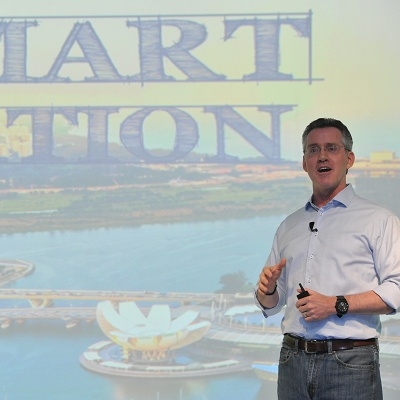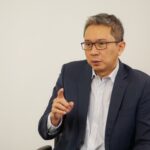By Cat Yong
When the Infocomm Development Authority of Singapore (IDA) kicked off their Smart Nation: Data Works conference last week, its Executive Deputy Chairman, Steve Leonard, reiterated Singapore’s ambition to be the first smart nation in the world.
IDA’s efforts could be distilled into four important components that are currently in the process of being put in place. First is data and analytics via a Data-as-a-Service pilot that would make datasets available for organisations to innovate on. Second is super connectivity or connectivity between everything, everyone, every where, and at all times.
The third component is a network of sensors that would continue to collect data via aggregation gateway (AG) devices all over the island nation, while last but not least, is a very vibrant start up ecosystem.
Leonard said, “Singapore stands apart from other countries in the region – people, technology and policy are coming together in a way that Singapore can pursue (to make a smart nation a reality).
He also pointed out two pressing concerns that Singapore faces in the future, which necessitates the steps that IDA is taking – increasing urban density to the point Singapore is the third most densely populated nation in the world, and also an ageing population. By 2050, the 65 and above age group would outnumber the 5 years and younger age group.
“To tackle difficult urban challenges in areas such as healthcare and energy, we need to capture and analyse massive amounts of data, and use that situational awareness to take meaningful actions.
“It is exciting for us to be exchanging ideas with top leaders in this space. Our goal is to challenge ourselves to keep finding new ways to better use data to serve citizen of all ages,” Leonard said.
The two-day event saw the likes of Cloudera, Amazon Web Services, Twitter, Facebook and a whole host of startups, coming together to trade experiences, tips, ideas and best practices.
Starting – where?
According to Alex Lin, Head of IDA’s investment arm, Infocomm Investments Pte. Ltd. (IIPL), Singapore’s smart nation vision still had gaps in it, which were startups. Gartner had also recently acknowledged the startup’s role in galvanising the Internet of Things (IoT) era, saying that this segment would contribute to 50 percent of IoT solutions, come 2017.
But, there were challenges trying to fuse startups and companies together, to achieve a smart nation. Lin said, “Startups are constantly trying to adjust themselves, while companies are executing business goals already.”
In light of this, IIPL has invested in two accelerator incubators – Joyful Frog Digital Incubator (JFDI), and most recently, the London-based Startupbootcamp FinTech, to work with startups.
Interestingly, startups shouldn’t be painted with the same brush, and some strategy is involved in approaching the different types that there are out there.
“Traditionally, 80-pecent of investments in growth stage startups will fail,” Lin observed. “For us to build the ecosystem, we have had to change our approach by looking upstream at early stage startups, and go into farming mode. For this, we work together with accelerators to groom early-stagers.”
The idea is that incubators have the structured processes necessary to groom startups, and a time period of 3 months is given for these startups to come up with a minimum viable product (MVP) and a sustainable business model.
“The graduation rate for this, is 50-percent,” shared Lin.
This is a vast improvement from 20-percent, and increases the pool of eligibles to go into incubation stage, whereby the startup, if it can still be called that, has to build its business and get customers.
About three prominent startup clusters are located in Singapore now, namely at Geylang, Orchard-City Hall and Blk71 at Ayer Rajah.
Sense and connectivity
IDA has also identified it needs to build a heterogenous network(HetNet), and intends to do this together with the industry.
IDA Assistant Chief Executive, Khoong Hock Yun, shared about a recently concluded briefing with telco providers in August, to discuss the trial scope and processes of this HetNet; an extension of the existing Wireless@SG and the National Broadband Network (NBN); that would cover the whole island nation
Lin had also later shared that for super connectivity to happen, handset makers and telco providers have to be involved, firstly to ensure devices are able to make the seamless handover from one connectivity tech to another, and secondly also to ensure there can be seamless handover from one service provider to another.
He observed, “(The latter) is a business model innovation.”
Another component, a network of sensors, involves deploying aggregation gateway (AG) boxes at city infrastructures like road junctions, overhead bridges, bus stops, parks and so on.
Khoong shared that a tender to select providers to deploy these boxes, would begin in November.
Lin explained, “It is important because sensors by itself is one element, but we need an aggregation box too. This will collect sensor data from all devices like phones, so we have data we can analyse.”
Data and analytics
Data-as-a-Service (DaaS) was also launched as an 18 month pilot during the Smart Nation: Data Works event. It is a pilot because it still aims to study the feasibility of addressing lack of dataset discovery through a federated approach ie. a platform, after which IDA will take its findings back to other local government agencies and work together and plan their next moves.
As such IDA is promoting its DaaS platform as a way for data providers to increase visibility of their datasets, and also feedback on how the platform can be further improved. The open source data portal platform CKAN or Comprehensive Knowledge Archive Network, can be found at http://ckan.org
Amazon Web Services (AWS) has stepped forward, providing usage credits worth USD3000, to each of the first 25 data providers to host their dataset and/or registries on AWS’ cloud.
SAP has also signed a two-year strategic collaboration with IDA, that involves working alongside institutes of higher learning and the industry, to develop local capabilities in Big Data and Analytics.
Both AWS and SAP would provide technical workshops, mentoring and resources in areas relating to their respective Memorandum of Intent (MOI) with IDA.
Conclusion
All these elements come together on the Smart Nation Platform (SNP), which was first introduced earlier this year by Singapore’s Minister for Communications and Information, Dr. Yaacob Ibrahim.
The SNP has three focus areas – Connect, Collect, Comprehend – which are aligned with the components discussed earlier in this article.
With even a live test bed well underway in the Jurong Lake District (JLD); up to 15 proof-of-concepts have been identified to be rolled out in parts of the 360 hectares area; Singapore’s smart nation goal looks to be well within the island nation’s grasp.
However IDA’s executive deputy chairman cautions that being a Smart Nation is about the journey, and not about the destination.
“It’s about an idea that startups, students and early tech are important (as well). We are experimenting already and this will evolve… we are already on our way,” Leonard said.
Other countries in the Southeast Asia region like Brunei and Thailand, are still only in early stage when it comes to start ups, at least.
Malaysia’s own startup scene has received more than its fair share of attention from venture capital companies, local and abroad, from private as well as government agencies. The government’s main emphasis currently, is also towards building Malaysia as a Big Data and Analytics (BDA) centre of excellence, more than anything else.








